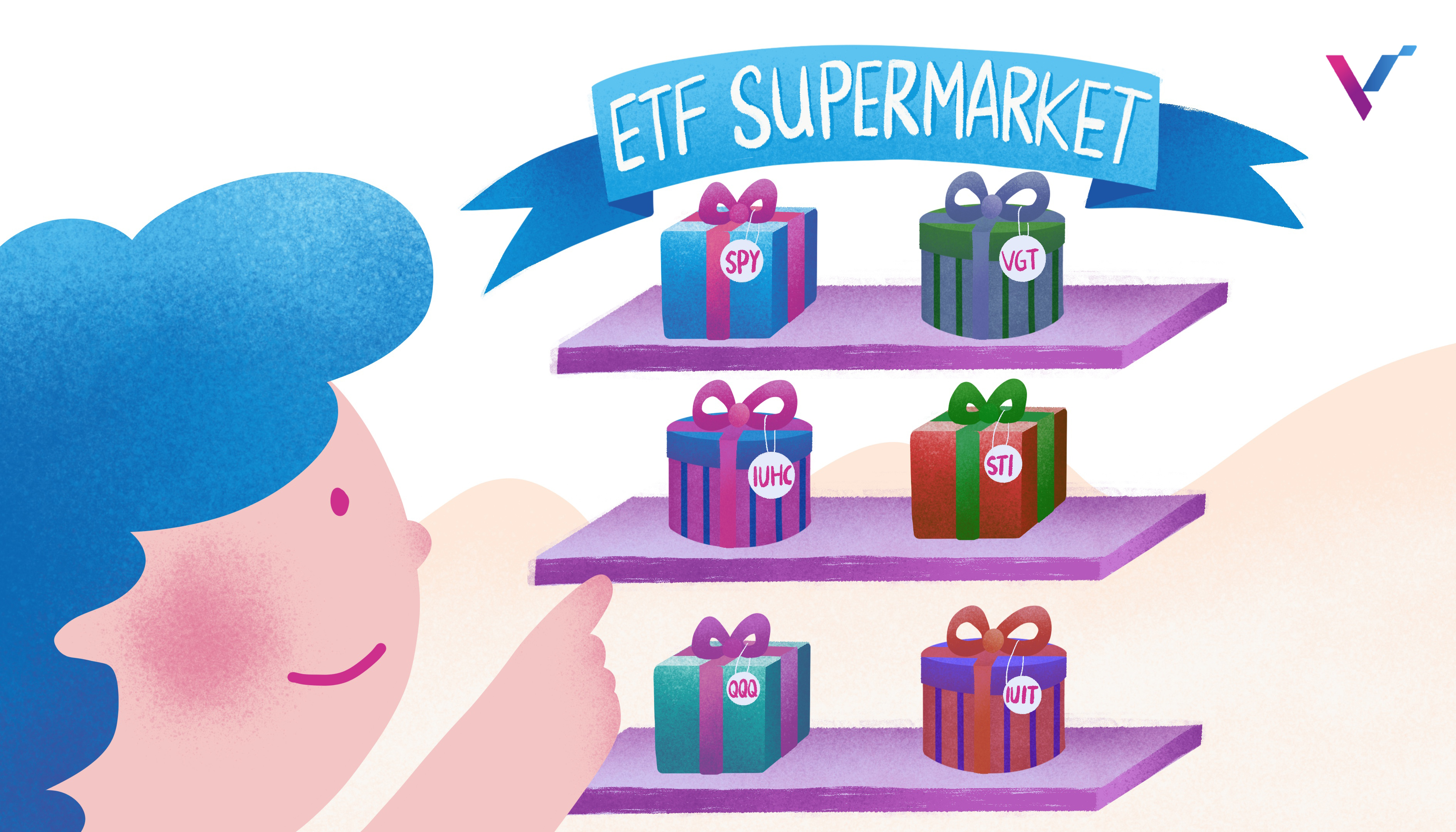ETF Investing 101: Guide for Beginners
30 Aug 2021

ETF or exchange-traded fund has been picking up steam recently as more and more investors are exploring this investment tool.
If you are interested to invest in ETFs but don’t know how to start, read on as we provide you with the relevant know-how in ETF investing for beginners.
ETFs defined
Before anything else, let us define what ETFs are.
Imagine the bag of goods sold at supermarkets for holidays like Chinese New Year and Christmas. The bag would have a variety of items which you can gift somebody or use at home.
Buying ETFs is like getting the same bag. When you buy an ETF, you’re essentially buying a set of stocks as a package instead of as individual shares.
See also: Finding the Best Stocks to Buy
If you buy the Straits Times Index (STI) ETF, for example, you get to own shares of the top 30 companies in Singapore, including DBS, Singtel, and CapitaLand. Yes, there’s no need to buy their stocks individually.
The same applies to buying the SPDR S&P 500 ETF (SPY) which has the S&P500 stocks, like Apple, Berkshire Hathaway, Tesla, Amazon, and Microsoft. Instead of buying shares in each of these companies, you can just purchase the SPY ETF.
Why invest in ETFs
We get why ETFs are suddenly in the limelight. After all, the ETF industry has showcased its potential for growth in the past few years, and it is poised to continue this upward trend in the future. But what really are the advantages of investing in ETFs?
1. Diversification
This is the top reason why you should consider ETFs. We all know that investment risks are reduced by diversifying our portfolios.
With ETFs, you don’t just have a few stocks in the same industry from your circle of competence, but a variety of stocks that perform well.
This also means you don’t need to put in a lot of effort analysing every stock there is as the stocks in ETF come in a package. Hence, this is best for those who are not yet too confident with their stock-picking skills yet want to have a diversified portfolio.
2. Liquidity
Most people compare ETFs to mutual funds. While the comparison is warranted, we want to emphasise one thing: you can trade ETFs like you trade a stock.
This means you can buy and sell ETFs throughout the day, whereas mutual funds can only be traded once per day when the market closes.
This trickles down to one thing – ETFs are highly liquid.
3. Lower cost
Buying individual stocks will cost you more than when you buy an ETF. For instance, it will cost you US$3,348 to buy an Amazon share. But if you buy the SPY ETF, it will only cost you US$450, and among the stocks you’ll have is Amazon.
This is not to say, however, that you should buy ETFs once you get the chance. You have to re-check your investment objectives before deciding to invest in ETFs.
Usually, ETFs are for those who have a long-term investment goal. They are not for the short-term investor.
ETFs also come with risks and some costs, as with all investment tools. You’ll need to pay an expense ratio or the annual fee for your total assets as well as commission fees when you do trades. And since ETFs are traded like stocks, ETFs are also affected by market fluctuations.
See also: Guide to Investing in Singapore
How to buy ETFs
Buying ETFs follows a similar process with stock purchases. First, you’ll need to open a brokerage account. In doing so, you have to consider which type of ETFs you’ll buy. Are you just looking to buy local ETFs, i.e. STI in Singapore, or do you plan on purchasing global ones, i.e. iShares MSCI China ETF or SPY ETF?
Once you know this, you’ll have a better idea of which brokerage account to use as some only allow you to buy locally. Likewise, buying ETFs in some exchanges is subject to taxes.
It’s also important to understand the different types of ETFs you can buy. As of date of writing, there are more than 7,000 ETFs traded around the world. While this may seem overwhelming, it would help you to know which type of ETF you want to buy.
The most popular type is the stock ETF that allows you to track an index, for instance, the S&P500 index, the Nasdaq100 index, and the Dow-Jones Industrial Average.
Bond ETFs, on the other hand, track bonds instead of stocks.
Commodity ETFs, as the name suggests, track indices with companies that operate in the oil, gold, and silver industries.
Meanwhile, there are sector-specific ETFs that are tailored to sectors like healthcare, real estate, energy, et cetera.
The most popular sector-specific ETF is REITs. There are also country-specific ETFs like the STI as mentioned above.
At the end of the day, it is your decision to pursue ETF investing or explore it as an investment tool to include in your portfolio. But remember one thing: Only invest if you know how to do it properly.
We’d love to help you out in investing in ETFs and stocks. If you’re interested, you can join our free online investment bootcamp.
DISCLAIMER
This article and its contents are provided for information purposes only and do not constitute a recommendation to purchase or sell securities of any of the companies or investments herein described. It is not intended to amount to financial advice on which you should rely.
No representations, warranties, or guarantees, whether expressed or implied, made to the contents in the article is accurate, complete, or up-to-date. Past performance is not indicative nor a guarantee of future returns.
We, 8VI Global Pte Ltd, disclaim any responsibility for any liability, loss, or risk or otherwise, which is incurred as a consequence, directly or indirectly, from the use and application of any of the contents of the article.
